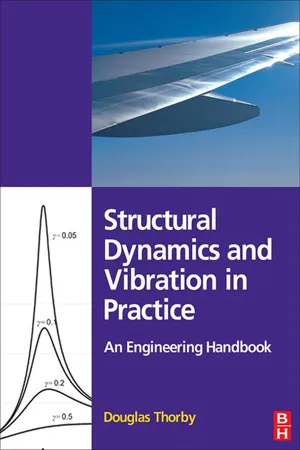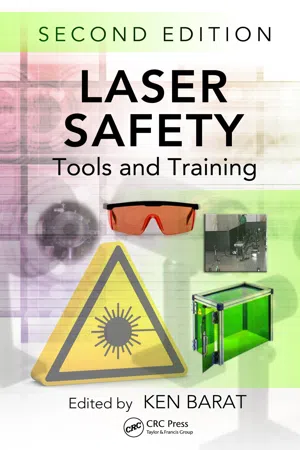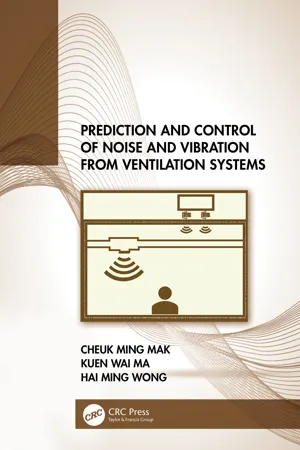Technology & Engineering
Vibration Isolation
Vibration isolation is a technique used to reduce the transmission of vibrations from a source to its surroundings or from the surroundings to the source. This is achieved by using various materials and mechanisms to absorb, dampen, or redirect the vibrations. Vibration isolation is important in engineering to protect sensitive equipment, improve performance, and enhance comfort.
Written by Perlego with AI-assistance
Related key terms
Related key terms
1 of 4
Related key terms
1 of 3
4 Key excerpts on "Vibration Isolation"
- eBook - ePub
Structural Dynamics and Vibration in Practice
An Engineering Handbook
- Douglas Thorby(Author)
- 2008(Publication Date)
- Butterworth-Heinemann(Publisher)
11Vibration Reduction
Contents11.1 Vibration Isolation 11.2 The dynamic absorber 11.3 The damped vibration absorber ReferencesThere are many examples in engineering where vibration levels can become so high that they threaten the structural integrity of the machine or structure concerned, the reliability of essential electronic equipment, or the health and efficiency of those exposed to it. In some cases it can be said that a high level of vibration is inherent in the design of a machine or vehicle, and measures to reduce it or isolate it are almost always needed, for example:(a) Reciprocating engines inevitably generate periodic forces that must be isolated from the vehicle interior in nearly all cases, and crankshaft torsional vibrations often have to be reduced, simply to prolong the life of the component.(b) Helicopter rotors can rarely be balanced well enough to avoid unacceptable periodic vibration in fuselage areas, and vibration reduction techniques are practically always required. (c) Combat aircraft often generate broad-band random vibration of sufficient severity to make Vibration Isolation necessary.In a case of severe vibration response, if the source cannot be removed, the obvious first move is to try to increase the damping of the mode or modes affected. This is often not possible, and Vibration Isolation and vibration absorption may then be considered.Vibration Isolation uses the properties of a single-DOF system, either to isolate sensitive equipment from a severe vibration environment or to isolate an environment, such as the interior of a vehicle, from vibration forces developed within, say, the engine. Vibration Isolation can be used with any form of vibration input. When used to reduce the effect of transients it is usually known as shock isolation.Vibration absorption can be provided by several different devices. All use an auxiliary mass (or rotational inertia), and they can be roughly classified as follows: - eBook - ePub
Laser Safety
Tools and Training, Second Edition
- Ken Barat, Ken Barat(Authors)
- 2017(Publication Date)
- CRC Press(Publisher)
Sites near highways and traffic can exhibit very high levels of low-frequency noise. Equipment located on upper floors can be exposed to building sway. Areas near loading docks can be subjected to significant noise from overhead doors or large seismic events caused when trucks bump the dock to find the stopping position, often times shaking the entire foundation of the building. Proper building design can reduce structural excitation and isolate the work environment from external seismic noise, so in many cases it is best to design solutions for these during construction or renovation before they become problematic. Reducing Unwanted Vibrations After an optimal location is selected for the sensitive system, the next step is to understand what level of vibration reduction is necessary and what solutions need to be used to reduce vibrations. Before exploring the various options, it is important to understand a few key vibration control terms and specifications. Vibration Isolation Isolators filter vibrations between structural elements by reducing the transmission of such disturbances. Isolation can be achieved through the use of springs, rubber pads, air-filled bladders, pneumatic self-leveling isolation legs, or active isolation systems using piezoelectric or electrodynamic elements. Each offer varying levels of capability, performance, and of course price. In most cases an isolation performance is measured by a reduction in noise (dB) or a transmissibility plot that shows the isolator’s performance over a specified frequency range. A sample transmissibility plot is shown in Figure 18.2. Because isolators prevent vibrations on the floor from reaching the work surface, they generally eliminate 70% of all vibration problems experienced in typical laboratories - Cheuk Ming Mak, Kuen Wai Ma, Hai Ming Wong(Authors)
- 2023(Publication Date)
- CRC Press(Publisher)
Chapter 4 Assessment of Vibration Isolation for machinery of ventilation systemsDOI: 10.1201/9781003201168-44.1 Introduction
Despite their benefits, ventilation ductwork systems produce airborne, duct-borne, and structure-borne sounds. Sounds are generated because the systems have vibrating mechanical machines, such as ventilation fans and motor-driven equipment. These machines may cause the roof or floor of the electrical and mechanical (E&M) equipment room to vibrate sufficiently high, rendering the spaces they serve unusable. Thus, satisfactory acoustic design plays an important role in the design of ventilation systems. Building acoustics is focused on the audio frequency range (or audible frequency range) 20–20 kHz as well as the octave or 1/3 octave scale and Bark scale for the frequency analysis in acoustic and psychoacoustic measurements, respectively. However, vibration or structure-borne sound analyses are typically centred on low frequencies (e.g., 0–200 Hz). This range includes frequencies from 20 to 200 Hz that humans may be able to hear and vibrations below 20 Hz that can be felt but are inaudible. The human perception of vibration and sound differs because our senses include hearing and touch. In addition, vibrations or structure-borne sound problems are typically analysed in a single-hertz band instead of the octave or 1/3 octave band.Figure 4.1 shows a schematic of a simple vibratory system for modelling a machine resting on a floor/roof. It includes a simple vibration isolator in relation to a vibrating source, structure-borne sound transmission path, and receiver. It also demonstrates several important aspects in the study of structure-borne sound transmission in buildings such as:- Structure-borne sound source characterisation,
- Vibration Isolation (assessment of performance using transmissibility),
- Vibrational waves produced in the floor/roof, and
- Coupling with air at the hearing end.
- eBook - ePub
- Marshall Long(Author)
- 2014(Publication Date)
- Academic Press(Publisher)
11Vibration and Vibration Isolation
Abstract
The chapter begins by outlining simple harmonic motion and its units of vibration, moving on to free and driven, damped and undamped oscillators, resonance, and Vibration Isolation. The principles of isolation are summarized. The chapter continues on to discuss vibrating equipment, inertial bases, and types of isolators, as well as the isolation of pipes and ducts. The chapter next illustrates two degree of freedom systems, that is, both undamped and damped. Finally we discuss floor vibrations including sensitivity to floor motion (steady and transient), response to impulsive and arbitrary forces, and footfall.Keywords
vibration ; isolation ; oscillator ; resonance ; inertial base ; damping ; floor ; impulse force ; Duhamel integral ; footfall11.1 .Simple Harmonic MotionUnits of Vibration
In most vibration problems we are dealing with harmonic motion, where the quantities can be expressed as sine or cosine functions. The general formula for the harmonic displacement of a body is given by(11.1)The velocity can be calculated by differentiating the displacement with respect to time:(11.2)The acceleration can be calculated by differentiating the velocity:(11.3)These lead to simple relationships between the amplitudes:(11.4)Displacement, velocity, and acceleration are vector quantities that have a fixed angular relationship with each other, as the vector plot in Fig. 11.1 illustrates. Each vector rotates counterclockwise in time about the origin at the radial frequency, ω. Velocity leads displacement by 90° and acceleration leads displacement by 180°.Figure 11.1 Vector Representation of Harmonic Displacement, Velocity, and AccelerationThe units used in vibration measurements are more varied than those for sound level measurements. Amplitudes can be expressed in terms of displacement, velocity, acceleration, and jerk (the rate of change of acceleration). Accelerations are given not only in terms of length per time squared but also in terms of the standard gravitational acceleration, g. The peak amplitudes are simply coefficients such as those shown in Eq. 11.4 . The root mean square (rms) value is the square root of the average of the square of a sine wave over a complete cycle, which is or 0.707 times the peak amplitude. Vibration amplitudes can also be expressed in decibels and Table 11.1
Index pages curate the most relevant extracts from our library of academic textbooks. They’ve been created using an in-house natural language model (NLM), each adding context and meaning to key research topics.
Explore more topic indexes
Explore more topic indexes
1 of 6
Explore more topic indexes
1 of 4



